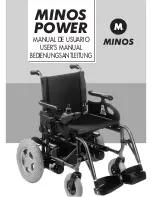
Form 07D –Frontier V4 Owner’s Manual ENGLISH.docx
Revision No.2
© Magic Mobility
Page 34 of 48
LED Battery Gauge:
(LEDs 1 – 10)
The batteries are charged if the battery gauge shows red, yellow and green.
(LEDs 1 – 7)
You should charge the batteries as soon as you can if the battery gauge
shows just red and yellow.
(LEDs 1 – 3)
You should charge the batteries immediately if the battery gauge shows
just red, either steady or flashing slowly.
Your battery gauge may also flash in different patterns to indicate your battery’s status
LEDs on, Steady: This indicates that all is well and displays your level of remaining charge.
LEDs Flashing Slowly: The control system is functioning correctly but needs charging.
LEDs Light up sequentially, Stepping Up: The wheelchair batteries are being charged. You will
not be able to drive the wheelchair until the charger is disconnected and you have switched
the control system off and on again.
How your battery gauge works:
The battery gauge lets you know how much charge is left in your batteries. The best way for you to
use the gauge is to learn how it behaves as you drive the wheelchair. Like the fuel gauge in a car, it is
not completely accurate, but it will help you avoid running out of “fuel”.
When you switch on the control system, the battery gauge shows an estimate of the remaining battery
charge. The battery gauge gives you a more accurate reading about a minute after you start driving
the wheelchair.
The amount of charge in your batteries depends on the way you use your wheelchair, the temperature
of the batteries and their age. These factors will affect the distance you can travel in your wheelchair.
All wheelchair batteries will gradually lose their capacity as they age.
If your battery gauge reading seems to fall more quickly than usual, your batteries may be worn out.
When you replace worn out batteries, fit the type recommended by Magic Mobility. If you use another
type, the battery gauge may be inaccurate.
7.6
Public Transportation
The Gel Cell batteries are Federal Aviation Administration (FAA) approved, allowing safe
transportation on aircraft, buses and trains. However, Magic Mobility recommends that any specific
requirements of the carrier are checked in advance. When flying with your wheelchair, please call the
airline for any specific information they need. Magic Mobility has a “flying with your wheelchair” fact
sheet on the website that covers most questions.
7.7
Battery Disposal and Recycling
If you encounter a damaged or cracked battery, contact your Magic Mobility Dealer for instructions
on disposal. Your Magic Mobility Dealer will also have all the necessary information on the recycling
of batteries as well as all other wheelchair parts, which is our recommended course of action.















































